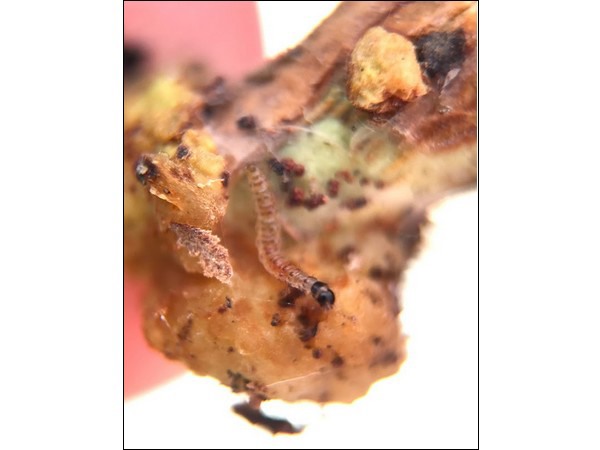A challenging pest of ornamental crops, Duponchelia fovealis (European Pepper Moth) can quickly multiply with potentially devastating results. Preferring to hide in dense crops, the caterpillars are difficult to control with chemical sprays. However, a biological control strategy involving a beneficial nematode and two predators is proving effective.
Originally from South-East Europe, Duponchelia has become a widespread pest in glasshouse-grown crops in Western Europe and North America. The caterpillars are proving particularly damaging in Kalanchoe, Begonia, and Cyclamen.

Scouting – where to look
“Drawn to high humidity, the caterpillars are often seen feeding on the plant base, the root neck, and leaves, or found boring into the plant stem,” explains Pascal Briand, IPM & Pollination Specialist at Biobest. “In pot plants, they can feed on the roots causing wilting and, by generating wounds, these caterpillars increase the disease pressure in the crop.”
Tiny eggs
Hardly visible to the naked eye, the tiny Duponchelia eggs are just 0.5mm long. A single female moth can lay up to 200 around leaf bases or near the veins at the base of the stalk.
Well-hidden caterpillars
The shiny cream-colored caterpillars, with a dark head and brown spots on their bodies, hatch around eight days later and grow to a length of 2-3cm. Difficult to scout, they tend to remain well hidden.
Substrate hiding pupae
Four weeks later, the fully grown caterpillars pupate inside cocoons hidden under substrate particles.
Highly mobile moths
Within a further 1-2 weeks, the adult moths appear. With cream-striped curved abdomens, they have distinctive brown marbled wings spanning 9-12mm. Highly mobile, these moths can spread quickly and easily in the crop.
Control strategy
Careful crop monitoring is recommended using delta traps - or a yellow trap placed horizontally in the crop - together with the appropriate pheromone.
Effective biological control strategies center on three products targeting the eggs and/or larval stages.
“To control the caterpillars in the substrate, we recommend introducing Carpocapsae-System,” says Pascal. “Containing the beneficial nematode Steinernema carpocapsae, it’s applied to the substrate or plant collar at the base of the stem.
“To target the moth eggs and young larvae, we advise releasing two soil-dwelling predators.
“Hypoaspis-System contains the soil-dwelling predatory mite Hypoaspis miles. This robust mite inhabits the top layer of substrate and is capable of surviving for several weeks in the absence of prey.
“Atheta-System contains the predatory rove beetle Atheta coriaria. Highly mobile, it actively searches for moth eggs and larvae in the substrate.”
For more information:  Biobest Group NV
Biobest Group NV
T: +32 14 25 79 80
info@biobestgroup.com
www.biobestgroup.com
